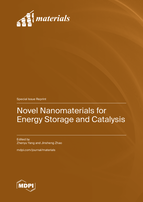Novel Nanomaterials for Energy Storage and Catalysis
A special issue of Materials (ISSN 1996-1944). This special issue belongs to the section "Energy Materials".
Deadline for manuscript submissions: closed (20 March 2024) | Viewed by 12690
Special Issue Editors
Interests: functional materials; materials processing; energy storage; catalysis; electrochemistry; batteries; electrocatalysis; solar cells; supercapacitors
Interests: electrochromic materials and device; photocatalysis technology for green energy; electrocatalysis and supercapacitor; anode materials and solid electrolyte for lithium cells
Special Issue Information
Dear Colleagues,
This Special Issue of Materials, “Novel Materials for Energy Storage and Catalysis”, considers papers describing the development of new functional materials and/or materials processing strategies with demonstrated practical applications in energy storage and catalysis. Theoretical calculations can be included, but all papers considered must have an experimental component. Any paper with a demonstrated application will be considered, including:
- Materials for electrochemical energy storage;
- Materials for thermal/thermochemical energy storage/conversion;
- Materials for catalysis reaction;
- Materials for electrocatalytic reactions;
- Materials for sensors;
- Materials for photo(electro)catalytic fuel production;
- Materials for solar cells.
Prof. Dr. Zhenyu Yang
Prof. Dr. Jinsheng Zhao
Guest Editors
Manuscript Submission Information
Manuscripts should be submitted online at www.mdpi.com by registering and logging in to this website. Once you are registered, click here to go to the submission form. Manuscripts can be submitted until the deadline. All submissions that pass pre-check are peer-reviewed. Accepted papers will be published continuously in the journal (as soon as accepted) and will be listed together on the special issue website. Research articles, review articles as well as short communications are invited. For planned papers, a title and short abstract (about 100 words) can be sent to the Editorial Office for announcement on this website.
Submitted manuscripts should not have been published previously, nor be under consideration for publication elsewhere (except conference proceedings papers). All manuscripts are thoroughly refereed through a single-blind peer-review process. A guide for authors and other relevant information for submission of manuscripts is available on the Instructions for Authors page. Materials is an international peer-reviewed open access semimonthly journal published by MDPI.
Please visit the Instructions for Authors page before submitting a manuscript. The Article Processing Charge (APC) for publication in this open access journal is 2600 CHF (Swiss Francs). Submitted papers should be well formatted and use good English. Authors may use MDPI's English editing service prior to publication or during author revisions.
Keywords
- functional materials
- materials processing
- energy storage
- catalysis
- electrochemistry
- batteries
- electrocatalysis
- solar cells
- supercapacitors







